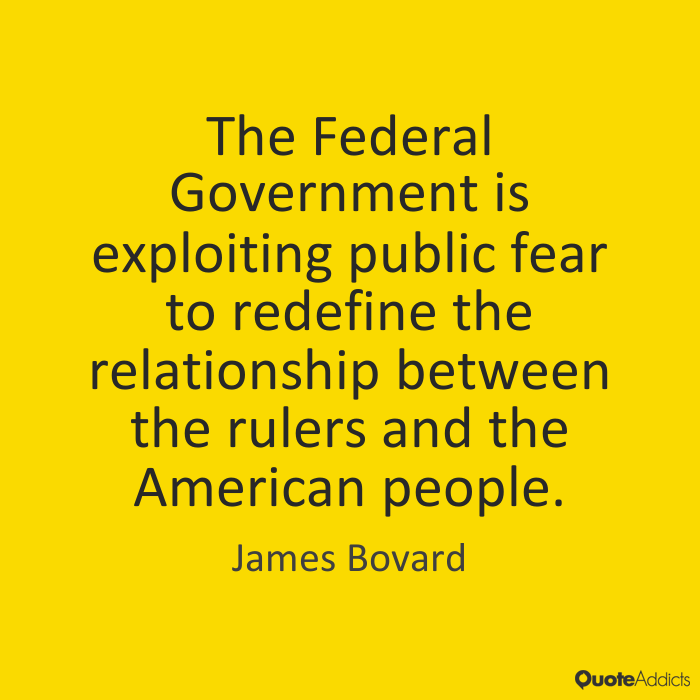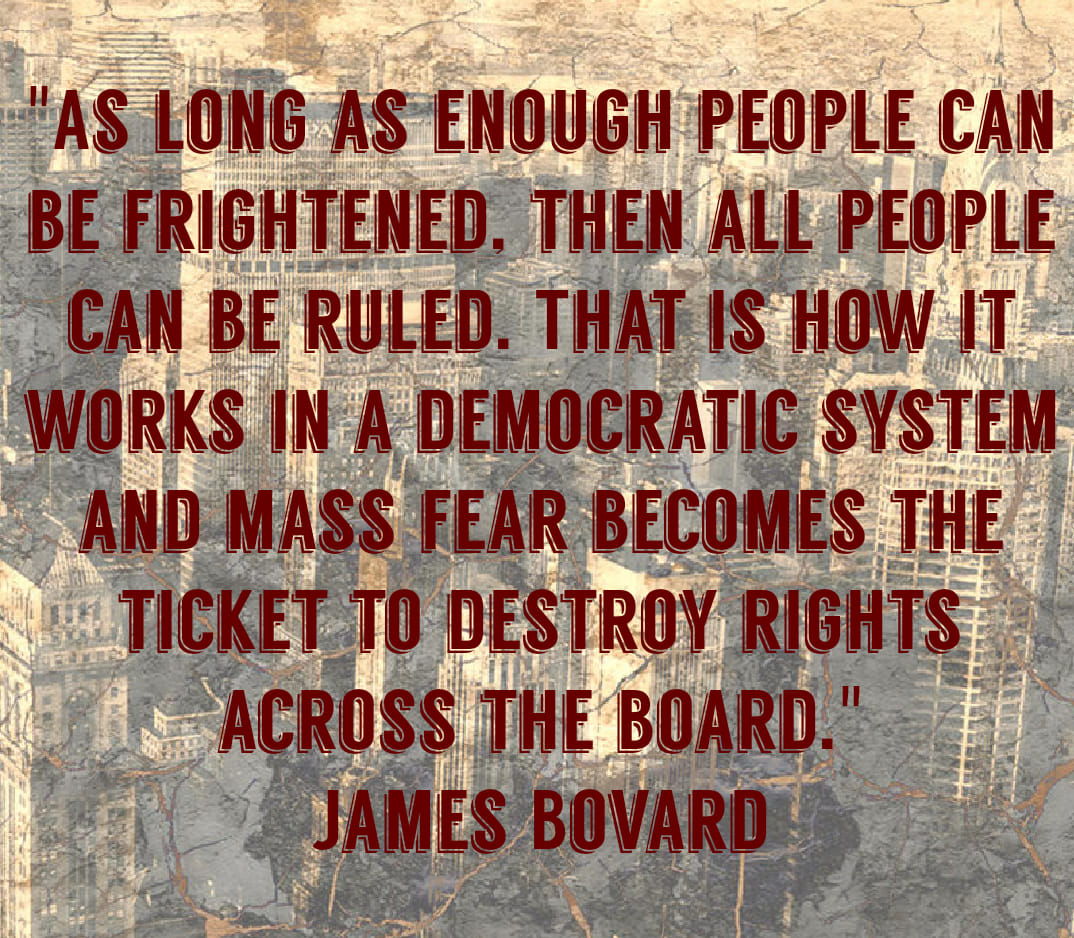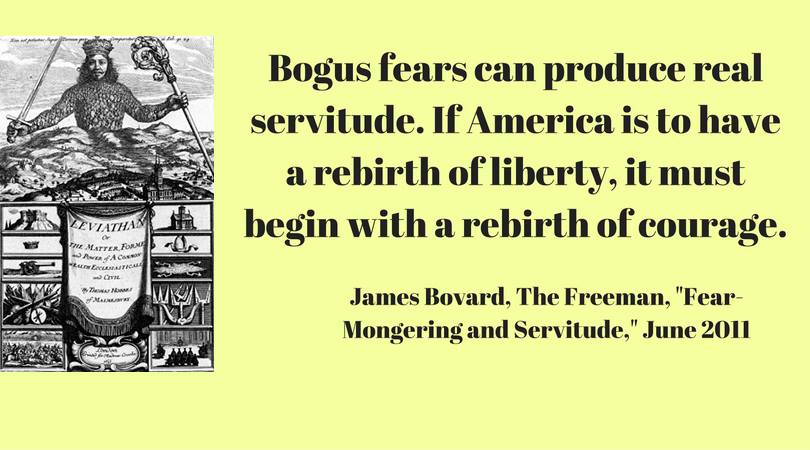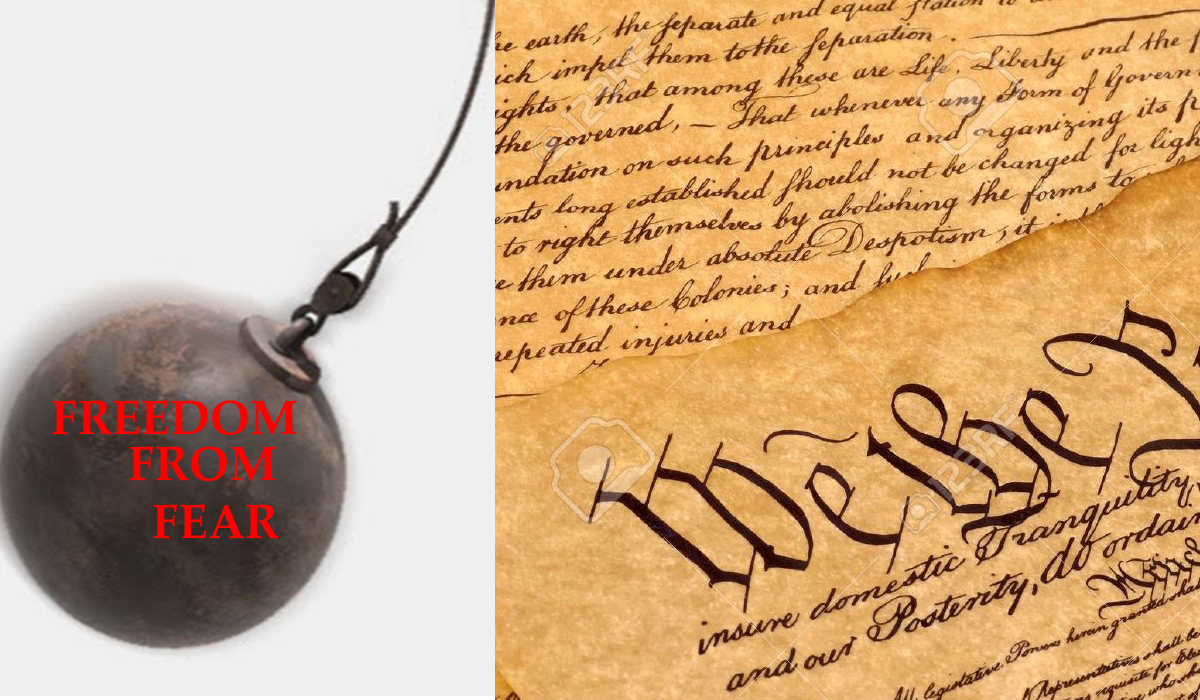The Democratic Party is championing presidential candidate Kamala Harris as a born-again champion of freedom. Earlier this year, Democrats shifted their focus from democracy to freedom, convinced that the latter word would enthrall voters on Election Day. Providing “freedom from fear” has become one of their most frequent political promises this past century.
Politicians routinely portray freedom from fear as the apex of freedom, higher than the initial freedoms buttressed by the Bill of Rights. While presidents have defined “freedom from fear” differently, the common thread is that it requires unleashing government agents. Reviewing almost a century of bipartisan scams on freedom from fear provides good cause to doubt the latest geyser of promises.
 “Freedom from fear” first entered the American political lexicon thanks to a January 1941 speech by President Franklin Roosevelt. In that State of the Union address, he promised citizens freedom of speech and freedom of worship—two cornerstones of the First Amendment—and added socialist-style “freedom from want” and “freedom from fear.” FDR’s revised freedoms did not include freedom to dissent, since he said the government would need to take care of the “few slackers or trouble makers in our midst.” Nor did FDR’s improved freedoms include the freedom not be rounded up for concentration camps, as FDR ordered for Japanese-Americans after Pearl Harbor. Three years later, FDR amended his definition of freedom by championing a Universal Conscription Act to entitle government to the forced labor of any citizen.
“Freedom from fear” first entered the American political lexicon thanks to a January 1941 speech by President Franklin Roosevelt. In that State of the Union address, he promised citizens freedom of speech and freedom of worship—two cornerstones of the First Amendment—and added socialist-style “freedom from want” and “freedom from fear.” FDR’s revised freedoms did not include freedom to dissent, since he said the government would need to take care of the “few slackers or trouble makers in our midst.” Nor did FDR’s improved freedoms include the freedom not be rounded up for concentration camps, as FDR ordered for Japanese-Americans after Pearl Harbor. Three years later, FDR amended his definition of freedom by championing a Universal Conscription Act to entitle government to the forced labor of any citizen.
Richard Nixon, in his acceptance speech at the 1968 Republican National Convention, promised, “We shall re-establish freedom from fear in America so that America can take the lead in re-establishing freedom from fear in the world.” Nixon asserted, “The first civil right of every American is to be free from domestic violence, and that right must be guaranteed in this country.” But with the Nixon scorecard, government violence didn’t count. He perpetuated the war in Vietnam, resulting in another 20,000 American soldiers pointlessly dying. On the homefront, he created the Drug Enforcement Administration and appointed the nation’s first drug czar. The FBI perpetuated its COINTELPRO program, carrying out “a secret war against those citizens it considers threats to the established order,” as a 1976 Senate report noted.
 President George H.W. Bush told the National Baptist Convention on September 8, 1989, “Today freedom from fear…means freedom from drugs.” To boost public fear, a DEA informant arranged for a knucklehead to sell crack cocaine to an undercover narc in Lafayette Park across from the White House. Bush invoked the sell a few days later to justify a national crackdown. He informed the American Legion, “Today I want to focus on one of those freedoms: freedom from fear—the fear of war abroad, the fear of drugs and crime at home. To win that freedom, to build a better and safer life, will require the bravery and sacrifice that Americans have shown before and must again.”
President George H.W. Bush told the National Baptist Convention on September 8, 1989, “Today freedom from fear…means freedom from drugs.” To boost public fear, a DEA informant arranged for a knucklehead to sell crack cocaine to an undercover narc in Lafayette Park across from the White House. Bush invoked the sell a few days later to justify a national crackdown. He informed the American Legion, “Today I want to focus on one of those freedoms: freedom from fear—the fear of war abroad, the fear of drugs and crime at home. To win that freedom, to build a better and safer life, will require the bravery and sacrifice that Americans have shown before and must again.”
Foremost among the sacrifices that Bush demanded was that of traditional liberties. His administration vastly expanded federal power to arbitrarily seize Americans’ property and increased the role of the U.S. military for domestic law enforcement. In a 1992 speech dedicating a new DEA office building, Bush declared, “I am delighted to be here to salute the greatest freedom fighters any nation could have, people who provide freedom from violence and freedom from drugs and freedom from fear.” The DEA’s own crime sprees, corruption, and violence were not permitted to impede Bush’s rhetorical victory lap.
On May 12, 1994, President Bill Clinton declared, “Freedom from violence and freedom from fear are essential to maintaining not only personal freedom but a sense of community in this country.” Clinton banned so-called assault weapons and sought to ban thirty-five million semi-automatic firearms. Gun bans in response to high crime rates mean closing the barn door after the horse has escaped. Citizens would presumedly have nothing to fear after they were forced to abjectly depend on government officials for their own survival. During Clinton’s first term, public housing authorities began mass warrantless searches of apartments to confiscate guns and other banned items. Clinton slammed a federal court ruling blocking the unconstitutional raids. When he visited the Chicago housing projects, Clinton declared, “The most important freedom we have in this country is the freedom from fear. And if people aren’t free from fear, they are not free.” In Clinton’s view, public housing residents had no right to fear the federally-funded housing police storming into their apartments.
 In February 1996, Clinton, seeking conservative support for his reelection campaign, endorsed forcing children to wear uniforms at public schools. Clinton justified the fashion dictate: “Every one of us has an obligation to work together, to give our children freedom from fear and the freedom to learn.” But, if mandatory uniforms were the key to ending violence, Postal Service employees would have a lower homicide rate.
In February 1996, Clinton, seeking conservative support for his reelection campaign, endorsed forcing children to wear uniforms at public schools. Clinton justified the fashion dictate: “Every one of us has an obligation to work together, to give our children freedom from fear and the freedom to learn.” But, if mandatory uniforms were the key to ending violence, Postal Service employees would have a lower homicide rate.
Senator Bob Dole, the 1996 Republican presidential nominee, repeatedly promised voters “freedom from fear” via crackdowns on crime. How did Dole intend to provide “freedom from fear”? By proclaiming that “we must…untie the hands of the police.” Dole did not specify exactly how many no-knock raids would be necessary to restore domestic tranquility.
George W. Bush, like his father, alternated promises of “freedom from fear” with shameless fearmongering. Prior to election day 2004, the Bush administration continually issued terror attack warnings based on flimsy or no evidence. The New York Times derided the Bush administration in late October for having “turned the business of keeping Americans informed about the threat of terrorism into a politically scripted series of color-coded scare sessions.” Yet each time a terror alert was issued, the president’s approval rating rose temporarily by roughly three percent, according to a Cornell University study. The Cornell study found a “halo effect”: the more terrorists who wanted to attack America, the better job Bush was supposedly doing. People who saw terrorism as the biggest issue in the 2004 election voted for Bush by a 6-to-1 margin.
 The most memorable Bush campaign ad, released a few weeks before the election, opened in a thick forest, with shadows and hazy shots complementing the foreboding music. After vilifying Democratic candidate John Kerry, the ad showed a pack of wolves reclining in a clearing. The voiceover concluded, “And weakness attracts those who are waiting to do America harm” as the wolves began jumping up and running toward the camera. At the end of the ad, the president appeared and announced, “I’m George W. Bush and I approve this message.” One liberal cynic suggested that the ad’s message was that voters would be eaten by wolves if Kerry won. The Bush ad spurred protests by the equivalent of the Lobo Anti-Defamation League. Pat Wendland, the manager of Wolves Offered Life and Friendship, a Colorado wolf refuge, Colorado, complained, “The comparison to terrorists was insulting. We have worked for years, teaching people that Little Red Riding Hood lied.”
The most memorable Bush campaign ad, released a few weeks before the election, opened in a thick forest, with shadows and hazy shots complementing the foreboding music. After vilifying Democratic candidate John Kerry, the ad showed a pack of wolves reclining in a clearing. The voiceover concluded, “And weakness attracts those who are waiting to do America harm” as the wolves began jumping up and running toward the camera. At the end of the ad, the president appeared and announced, “I’m George W. Bush and I approve this message.” One liberal cynic suggested that the ad’s message was that voters would be eaten by wolves if Kerry won. The Bush ad spurred protests by the equivalent of the Lobo Anti-Defamation League. Pat Wendland, the manager of Wolves Offered Life and Friendship, a Colorado wolf refuge, Colorado, complained, “The comparison to terrorists was insulting. We have worked for years, teaching people that Little Red Riding Hood lied.”
Bush’s campaign to terrify voters into granting him four more years to rule America and much of the world did not deter him from announcing a few months later in his State of the Union address, “We will pass along to our children all the freedoms we enjoy, and chief among them is freedom from fear.” This was back when the mainstream media was continuing to hail Bush as a visionary idealist, prior to the collapse of his credibility on the Iraq war, torture, and other debacles.
 President Joe Biden milked “freedom from fear” in a Pennsylvania speech earlier this year on what he labeled “the third anniversary of the Insurrection at the United States Capitol.” Biden revealed plans to turn the November election into a referendum on Adolf Hitler, accusing Donald Trump of “echoing the same exact language used in Nazi Germany.” CNN reported that Biden campaign aides planned to go “full Hitler” on Trump. Biden spent half an hour fearmongering and then closed by promising “freedom from fear.” This was the famous Biden two-step—demagoguing to his heart’s content and then closing with a few schmaltzy uplift lines, entitling the media to re-christen him as an idealist.
President Joe Biden milked “freedom from fear” in a Pennsylvania speech earlier this year on what he labeled “the third anniversary of the Insurrection at the United States Capitol.” Biden revealed plans to turn the November election into a referendum on Adolf Hitler, accusing Donald Trump of “echoing the same exact language used in Nazi Germany.” CNN reported that Biden campaign aides planned to go “full Hitler” on Trump. Biden spent half an hour fearmongering and then closed by promising “freedom from fear.” This was the famous Biden two-step—demagoguing to his heart’s content and then closing with a few schmaltzy uplift lines, entitling the media to re-christen him as an idealist.
Biden did not survive the Democrats’ version of the Night of the Long Knives and Vice President Kamala Harris has been designated the party’s presidential flagbearer. Harris painted with an even broader brush than most politicians. At a Juneteenth Concert this summer, she condemned Republicans for “a full-on attack” on “the freedom from fear of bigotry and hate.” Harris implied that politicians could wave a psychological magic wand to banish any bias in perpetuity. How can anyone have “freedom from fear of bigotry” unless politicians become entitled to perpetually control everyone’s thoughts?
In August, the Democratic National Convention whooped up freedom in ways that would qualify as “authentic frontier gibberish,” as the 1974 movie Blazing Saddles would say. A campaign video promised “freedom from control, freedom from extremism and fear.” So Americans won’t have true freedom until politicians forcibly suppress any idea they label as immoderate? The Democratic Party platform warned, “Reproductive freedom, freedom from hate, freedom from fear, the freedom to control our own destinies and more are all on the line in this election.” But the whole point of politics nowadays is to preempt individuals from controlling their own destinies. Regardless, a Time magazine headline hailed “How Kamala Harris Took ‘Freedom’ Back from the GOP.”
“Freedom from fear” is the ultimate political blank check. The more people government frightens, the more legitimate dictatorial policies become. Pledging “freedom from fear” entitles politicians to seize power over anything that frightens anyone. Giving politicians more power based on people’s fears is like giving firemen pay raises based on how many false alarms they report.
Politicians’ promises of “freedom from fear” imply that freedom properly understood is a risk-free, worry-free condition. It is the type of promise that a mother would make to a young child. Freedom is now supposedly something that exists only in the womb of government paternalism. “Freedom from fear” is to be achieved by trusting everything that politicians say and surrendering everything that politicians demand. New Mexico Governor Michelle Grisham epitomized that mindset when she proclaimed at the Democratic National Convention, “We need a president who can be Consoler-in-Chief. We need a president capable of holding us in a great big hug.” And continuing to hold us until we formally become psychological wards of the state?
“Freedom from fear” offers freedom from everything except the government. Anyone who sounds the alarm about excessive government power will automatically be guilty of subverting freedom from fear. Presumably, the fewer inviolable rights the citizen has, the better government will treat him. But as John Locke warned more than 300 years ago, “I have no reason to suppose, that he, who would take away my Liberty, would not when he had me in his Power, take away everything else.”
Why not simply offer voters “freedom from the Constitution”? “Freedom from fear” means security via mass delusions about the nature of political power. Painting the motto “freedom from fear” on shackles won’t make them easier to bear. Perhaps our ruling class should be honest and replace the Bill of Rights with a new motto: “Political buncombe will make you free.”



Comments are closed.